4 Easy High Paying Jobs Feeding Cheetahs
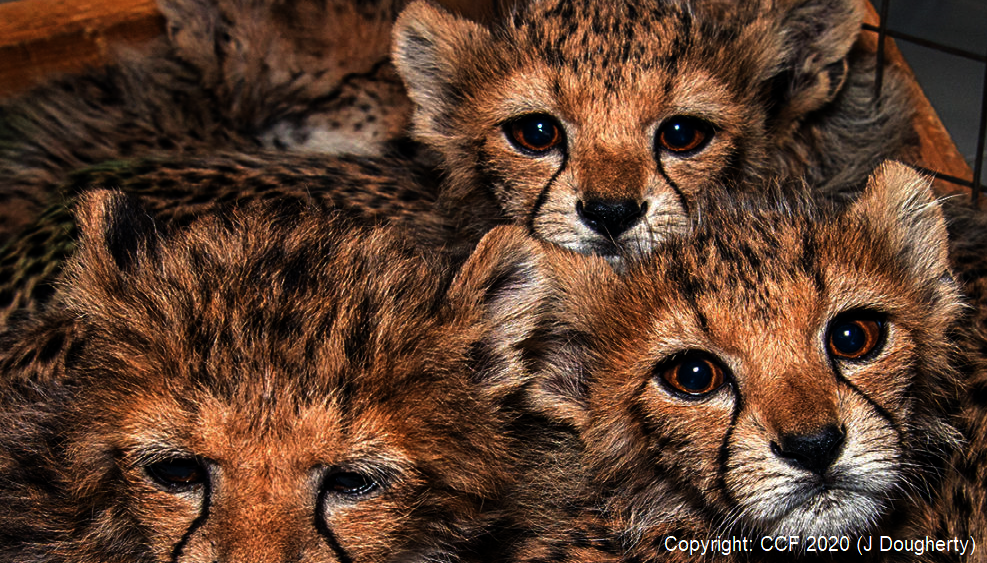
Confiscated Cubs - photo by James Dougherty
Meet Dr. Marshall and Nathalie Santerre. Hailing from Ottawa and Quebec respectively, Dr. Ashley Marshall (Lead Vet) and Nathalie Santerre (Head Animal Keeper of Safe House 3) arrived in Somaliland, in March and April respectively, and have found a common thread in their Canadian approach to frontline conservation work.
Nathalie brings with her almost 20 years of expertise working in conservation programs with captive cheetahs which is a boon for managing the growing captive population in Somaliland.
As an emergency veterinarian with an equal passion for cats and travel, Ashley is learning the nuances of working with cheetahs. Through their time here together, they have brought ease, flexibility and a great sense of humour to the team as they work tirelessly to manage basic needs such as keeping the animals clean, healthy, well fed and engaged.
Additionally, they work closely to provide preventative medical care, such as vaccines and deworming, health monitoring, including blood and fecal assessments, and responding to any medical issues that may arise. Work with the cheetahs is mostly free contact and a large part of training includes getting the cheetahs used to physical manipulation and the squeeze cage for safe medical assessments.
Ashley and Nathalie describe what makes their job so special and so challenging. One of the more trying parts of the job is when a call comes in alerting the team to a group of stolen cubs. Typically ranging in age from 1 to 6 months, and in group sizes of up to 15 individuals, CCF works closely with the Ministry of Environment and Climate Change (MoECC) to access the cubs and take over their care.
Often arriving dehydrated and malnourished, covered in wounds and parasites and sometimes with ties and chains around them, it's an uphill battle to efficiently and calmly assess, stabilize and offer them comfort.
The work is minute by minute – initially, after providing supportive care and nutrition, they are settled into safe, warm enclosures and monitored closely.
After a period of quarantine and acclimation, samples and measurements are taken in the least stressful manner. The veterinary team treats them for the treatable and slowly introduces them to adequately nutritious meals so as not to overwhelm their systems. But, even then, they can decline and unfortunately not all the confiscated cubs survive.
Gratifying work as well as some heartbreak. The team works tirelessly around the clock in these initial days and the wins and the losses are felt immensely. For those that survive, we bond with the youngsters and feel pride in watching them grow into their bodies and their personalities which makes it all worthwhile.
Additionally, the data collected from the confiscation and from the medical assessments are used in court to help prosecute the poachers. Under the Forest and Wildlife Conservation Law (Act 69/2015), the current fine is 3/40 million Shillings and 1/5 years prison (Somalilander/Foreigner), hunting weapons and transportation used are also confiscated.
Working for CCF in Somaliland is beyond gratifying. It is an active, non-stop job that is truly on the frontlines of conservation within the illegal wildlife trade. We are not only grateful for the opportunity to contribute but have also shared knowledge, experience and made friends with other likeminded passionate conservationists from both Somaliland and around the globe.
As the cats will soon be moved to a bigger facility, out of the city with the opportunity to live in larger enclosures and have an opportunity to express more natural behaviours, we hope our presence is needed less. But until then, CCF will with continue to confront these issues, heart faced forwards.
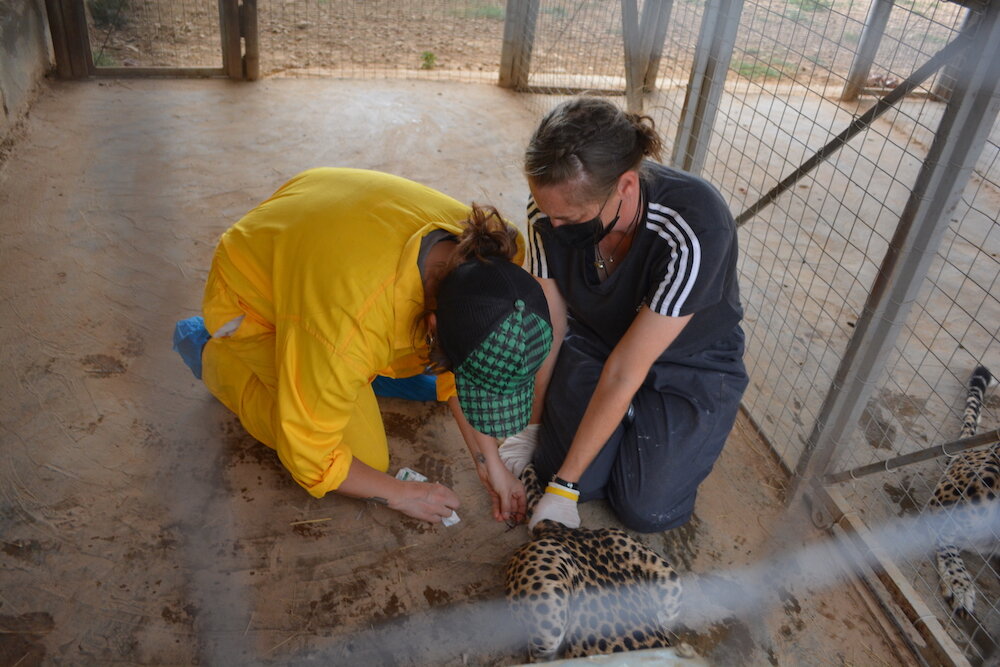
Ashley and Nathalie at work
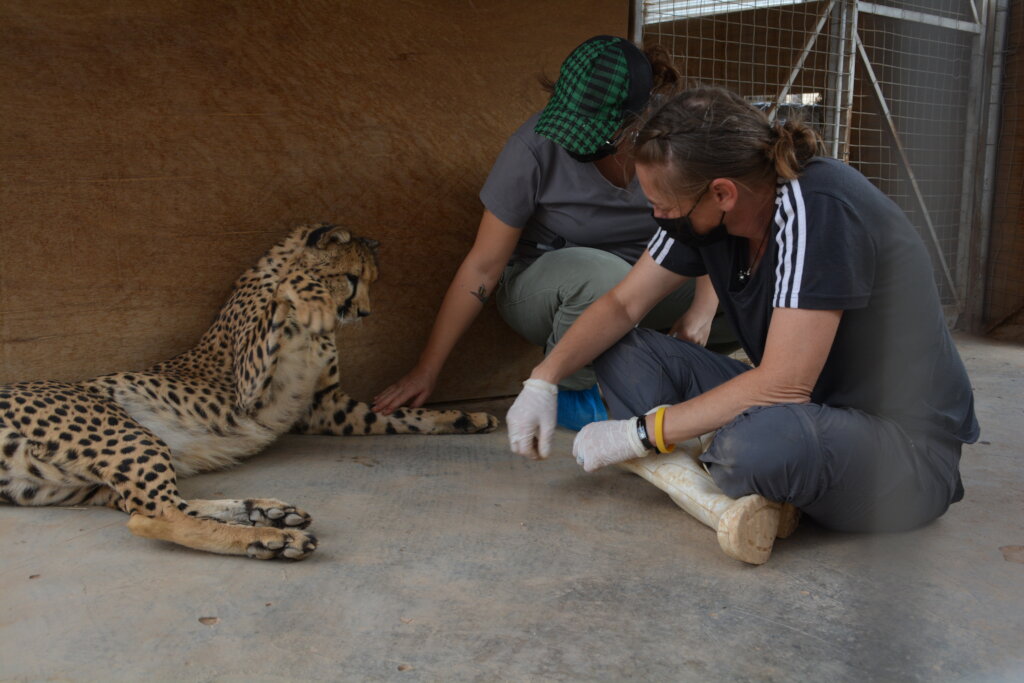
Ashley and Nathalie working with larger cub
Links:
- youtube
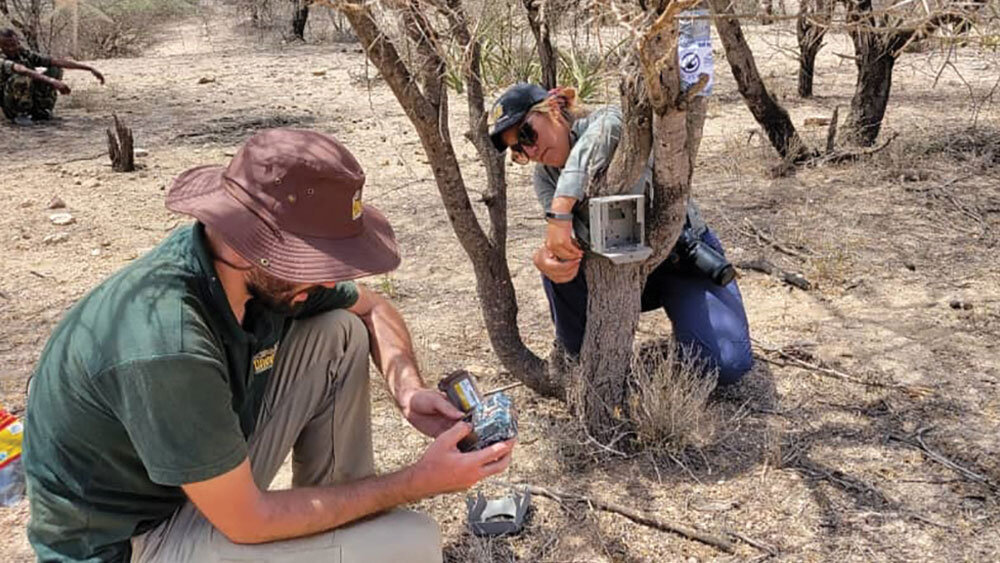
Bogdan Cristescu & CCF Staff Checking Camera Traps
February 2022 marked my one-year anniversary as the Assistant Director for Ecological Research at the Cheetah Conservation Fund (CCF). When I joined the team, results from many of the long-term research projects happening at CCF and across the cheetah's range in Africa, were being published in a variety of scientific journals.
In April of last year, research on the effectiveness of scat detection dogs for locating cheetah scat was published. That same month, we also published a research paper on scent marking behaviors in leopards and cheetahs. I help disseminate the data that CCF has collected on cheetah ecology and behavior, to form better conservation strategies. For the entire year, research was published on almost a monthly basis.
The topics CCF researched last year ranged widely from the effectiveness of livestock guarding dogs at minimizing human-wildlife conflict, captive rearing of African wild dogs, and hornbill biology. The unifying theme throughout all the research is the cheetah. The information we collect across the cheetah's range helps us to achieve two core missions – save the cheetah and conserve the cheetah's wild habitat.
Thanks to you , we are maintaining and restoring healthy ecosystems that can support not only cheetahs but other incredible wildlife too. Funding support makes it possible to bring policymakers together with community members to curb illegal wildlife/pet trade. Your donations mitigate human-wildlife conflict by enabling the placement of Livestock Guarding Dogs with livestock farmers, and by providing livelihood-enhancing training in predator-friendly farming techniques. And with your help , our work is safely and responsibly returning rehabilitated, orphaned cheetahs to the wild.
Though I began formally working here last year, I have been involved with CCF since 2016. I first came to CCF as a Visiting Researcher after completion of my first postdoctoral position with the University of Cape Town in South Africa. I worked in the Northern Cape of South Africa – the largest province in South Africa, bordering both southern Namibia and Botswana. My postdoc research in the Northern Cape was focused on carnivores as part of project PEACE – Predator Ecology and Coexistence Experiment. The project aimed to test the ecological and economical effectiveness of non-lethal methods at preventing livestock predation. In short, we were studying human-wildlife conflict, which constitutes one of the primary threats to the cheetah.
While I was studying in South Africa, Drs. Laurie Marker, CCF's Founder and Executive Director, and Anne Schmidt-Küntzel, CCF's Assistant Director for Animal Health and Research, were very busily gathering the leading researchers in the conservation, biology, and ecology of cheetahs with the goal of publishing the first-ever comprehensive scientific textbook on the species – Cheetahs: Biology and Conservation. I was very happy to be given the opportunity to contribute to six chapters of the book. While for me this was an outstanding opportunity, CCF is well-known for bringing people together on research and conservation projects across the cheetahs' range.
This year, CCF welcomed a delegation from India, and Dr. Marker just returned from a trip to Uganda looking at potential reintroduction sites for cheetah. These countries, among many other former and current cheetah range countries where cheetah populations are at present either absent or small, are increasingly interested in reintroducing cheetahs.
In Angola, CCF's scat detection team recently completed a scat gathering excursion in cooperation with a University in Brazil – CIBIO. Over the years, CCF has found increasing evidence of the species' return to Angola, where the cheetah was once thought to be regionally extinct.
In Somaliland, I joined Dr. Marker and other members of our local team and along with staff from the Ministry of Environment and Climate Change we conducted a weeklong survey of the western region of Somaliland. Talking with the pastoral farmers, we are beginning to get a better idea of the current distribution of cheetahs in the region, as well as the role of human-wildlife conflict in the supply side of the Illegal Wildlife Trade in cheetahs.
It is important to understand regional and local contexts as well as underlying causes to effectively minimize the trade; the CCF dedicated team in Somaliland are currently caring for more than 80 confiscated cheetah cubs, which is likely the tip of the iceberg of a widespread and significant challenge to the persistence of wild cheetah populations in the Horn of Africa.
None of these projects and associated conservation recommendations would be possible without a substantial volume of research conducted at every step. Your support allows CCF to be a leader in cheetah research. Thanks to you, we are positioned to serve as a Centre of Excellence in comprehensively studying the species and its ecosystems.
Bogdan Cristescu, PhD
Assistant Director for Ecological Research
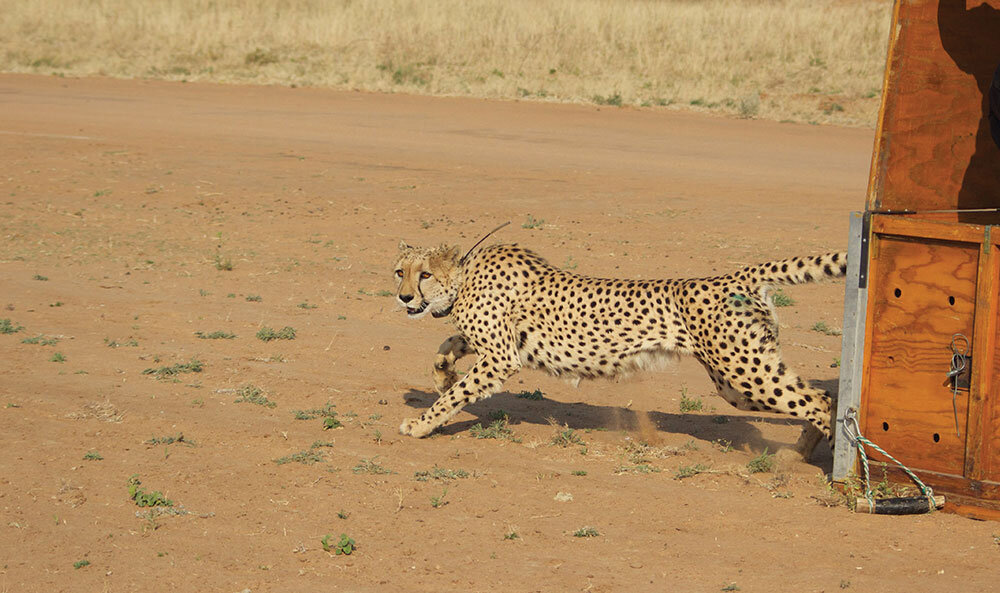
Cheetah Release at CCF
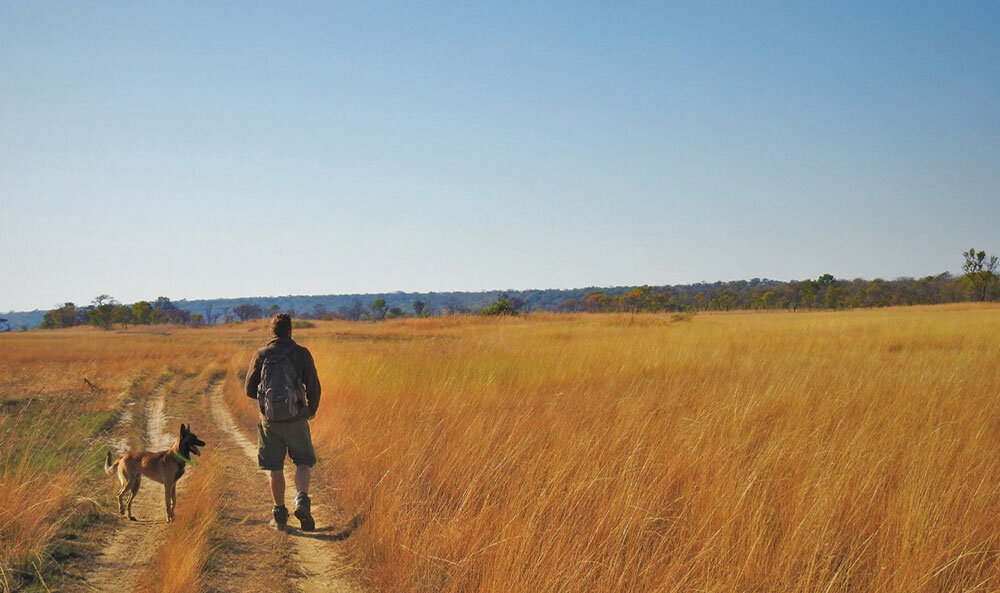
CCF Scat Dog and CCF Staff
Links:
- Youtube
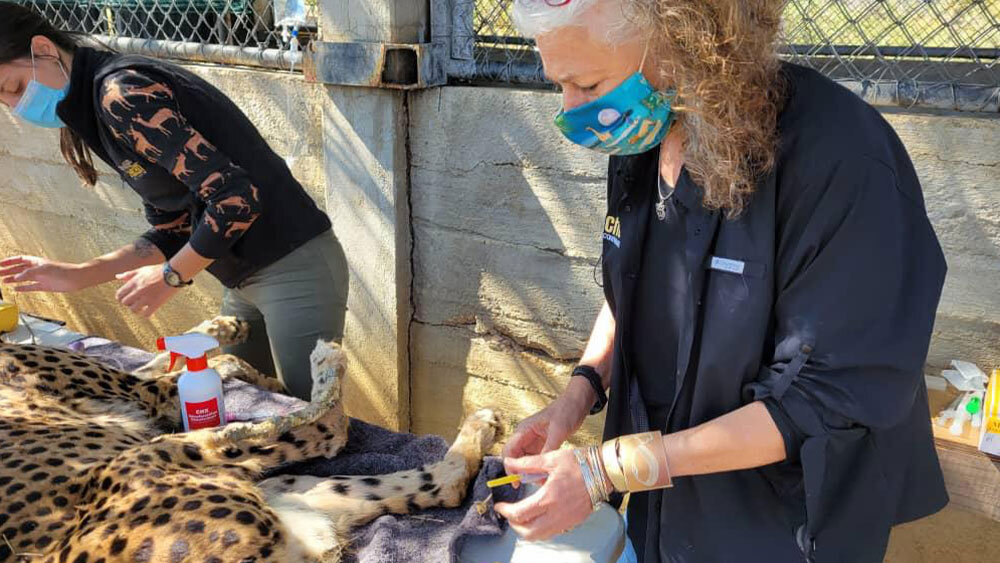
Dr. Marker leading the workup on Daenarys
Since February, CCF vets have been busy with an interesting and challenging case. As many have seen via social media updates, our cheetah Daenerys went through quite a lot in her past months, but she is now in her path to recovery.
Daenerys came to CCF as a cub in 2016 and was successfully rehabilitated and released into Erindi Private Game Reserve. Natural Habitat Adventures helped fund the GPS collars used to monitor her post-release movements. During the pandemic lockdown, CCF's staff noticed an issue with her movements via GPS. Erindi's staff went to investigate, and a guide spotted her limping. She had broken her fibula and dislocated her tibia-tarsus articulation, with all her ankle ligaments getting ruptured. This was a potentially life threatening injury that meant Daenerys needed to be recaptured. She could not remain out in the wild and successfully survive independently.
Once we got her back to CCF's Centre we discovered that she was also pregnant! This made the decision to pull her from Erindi even more critical; it was not just Daenerys' life on the line but a new generation of cheetahs.
After three long surgeries, Daenerys was finally set on the way to recovery. We placed an external fixator, which is a series of metal pins attached to the bone through incisions into the skin. She had the surgical wound cleaned weekly at the time, and she will keep the fixator until the end of 2021. Once her joint heals completely, the pins can be removed.
As she recovered, we initially restricted her movement, but now she is in a larger enclosure where she can walk and get a bit of exercise. She is doing fine and putting weight on her leg when walking. CCF's vet team and Cheetah Keepers work on her monthly to x-ray and evaluate her healing. In addition, we need to monitor her joints and see how her muscles are rebuilding.
Khaleesi (her cub seen below) was born during the recovery period, and due to the nature of Daenerys's injuries, CCF staff stepped in, and now Khaleesi is being hand raised.
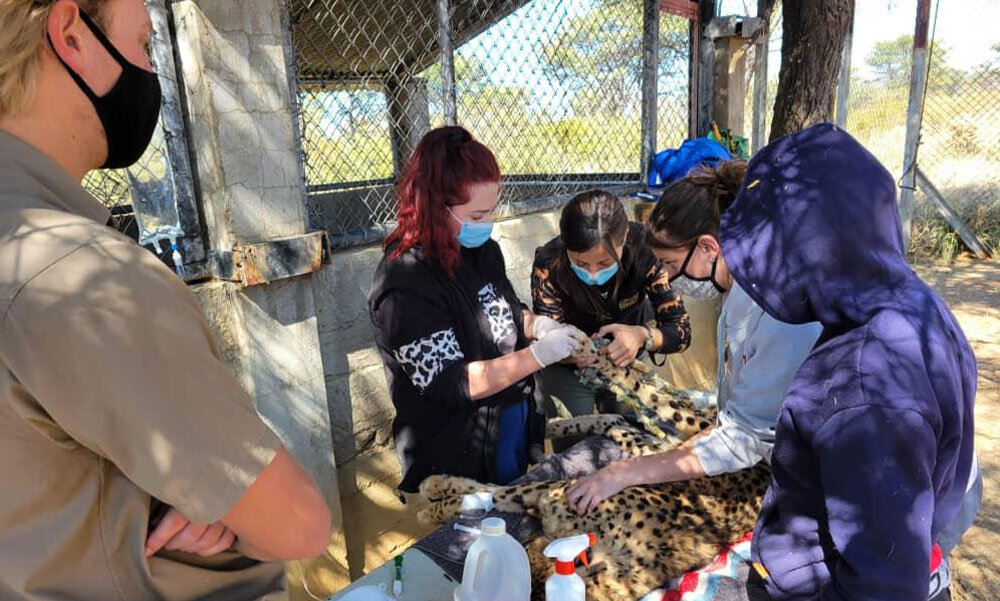
Daenarys in her workup
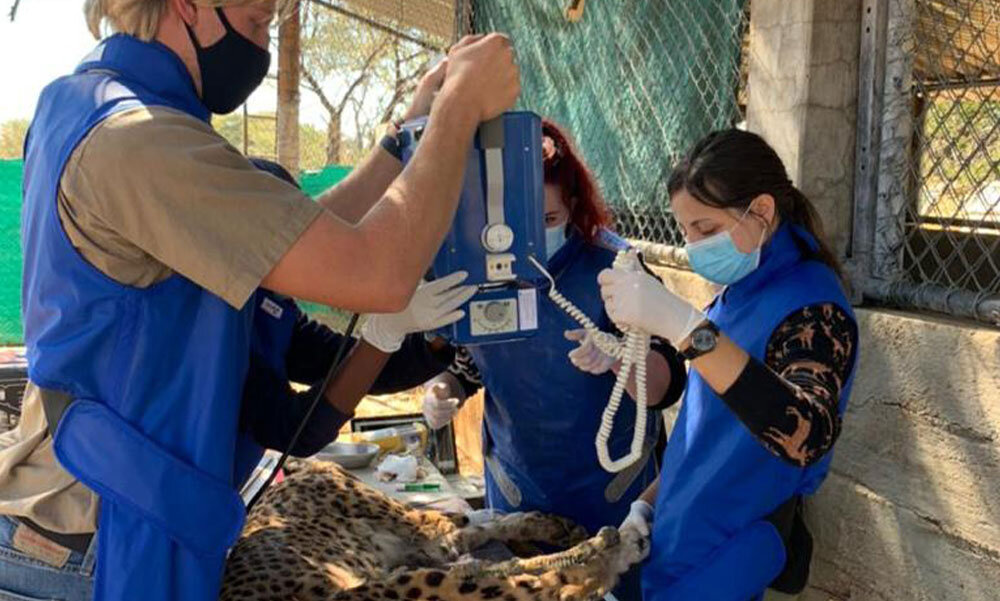
Taking an x-ray of Daenarys' leg
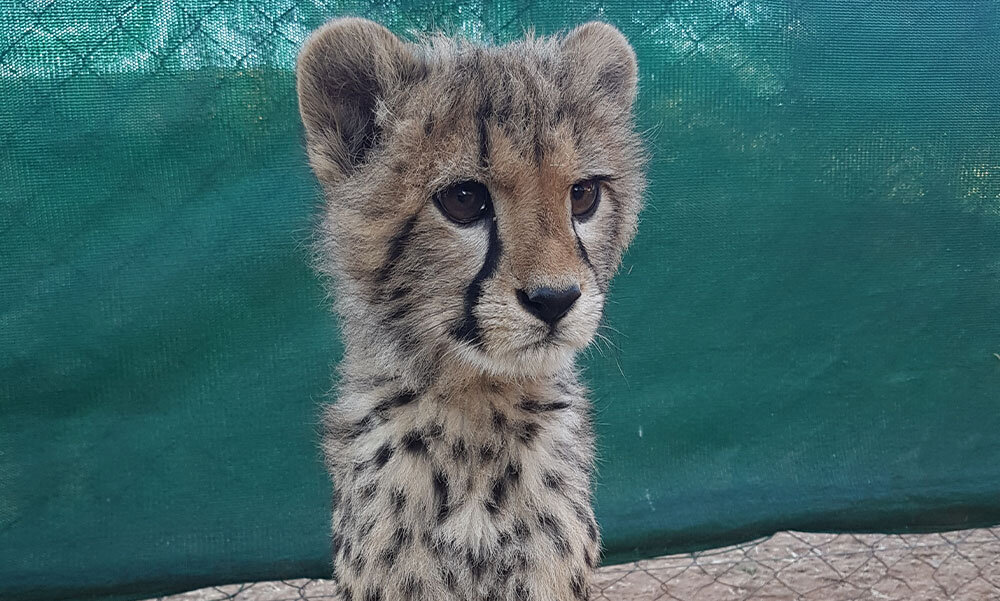
Khaleesi
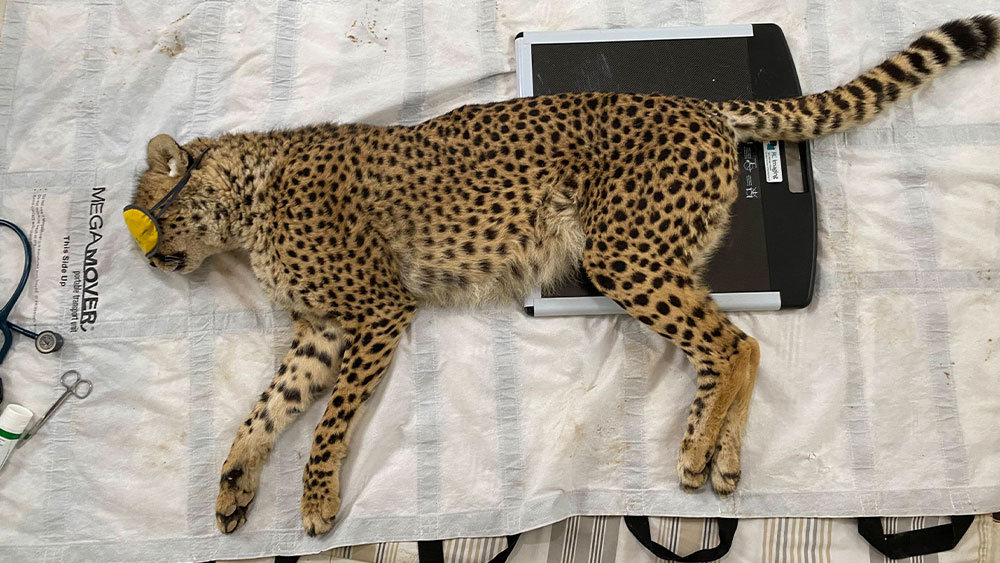
Duma getting an X-Ray
As a vet I often get asked who my favourite patient is, or which one of my cases have been most fulfilling or enjoyable. Predictably I find it a hard question to answer, I have been lucky in my career so far to have worked with some amazing animals, from dogs to elephants to rhinos, and of course cheetah. So having to choose just one is tough, but one patient and one case in particular that I can say for certain is up there amongst my favourites is Duma.
Duma is an adult male cheetah that was rescued from the horrible world of the illegal wildlife/pet trade that plagues the world. It has reduced our beautiful wildlife to mere objects of human entertainment and symbols of 'power'. It has caused a lot of pain and suffering for many species of wildlife across the world, including the iconic Cheetah.
Known as the fastest land animal on the planet, with their iconic spotted pattern they are amongst the most famous and recognisable species on the planet, people from all over the world will travel to Africa just to catch a glimpse of them in the wild. But many of them are victims of the illegal pet trade, parents killed, cubs stolen and smuggled across the continent and the globe to become someone's pet. Most of them won't even survive the journey, and the ones that do suffer a number of serious health issues, malnutrition, parasitic infestations, deadly viral diseases to name a few.
One common issue is malnutrition, being taken away from their mother's so young they miss out on the vital milk that their mother's provide that prepares them for life, and they won't get fed properly, or sometimes even at all and this will lead to many nutritional deficiencies and even starvation. In particular calcium is something they often lack, and this can lead to poor bone development leading to weak bones as they grow, Duma was one of these unfortunate animals.
So one night whilst in his enclosure he fell after being spooked and fractured his pelvis (as far as we know), for a cheetah this can be a fatal injury, the pelvis is such an important part of the body and once that is broken, walking, running, sitting, lying down, even going to the toilet can be a huge issue, and for a wild animal this would usually mean death if another predator finds you in that condition or it seriously hinders your ability to hunt. Since Duma has been with us since he was a young cub he is used to humans and used to being in close contact with us (the keepers and the vets) so he is not completely wild, which for his treatment and recovery was a good thing as we were able to provide the best possible care for him.
So for the first 3 months he was put on strict 'bed' rest and on daily pain relief, kept in a small enclosure to minimise how much he could move around, because if left in the larger enclosure with the other 5 adult male cheetah in his coalition he would have made his injury much worse, it is hard to ask a cheetah to rest, you have to force them! Mentally this a huge challenge to put an animal in a small enclosure for 3 months, where he can see his friends on the other side of the fence in the open, and for a lot of the other cheetah this would have been too much to ask of them as would put a lot of mental stress onto them, but thankfully Duma is one of the most gentle and patient animals I have worked with and his demeanour always remained upbeat and friendly, everyday when we would go into to feed him or check on him or just to spend time with him he was always bright and happy, which makes my life as his vet a lot easier.
Once 3 long months had passed, we took x-rays of his hip to see how the healing process had been doing and the fracture had healed really well and he seemed more comfortable on his hip, which was great news! Now that his bones had healed the next step in his recovery was to address the muscle loss in his hips, since he had not been walking or using his hips for much at all for 3 months he lost a lot of muscle around his pelvis and they had become stiff, which was to be expected. So the next step would be rehabilitation/physiotherapy, which is a common part of recovery from a fractured pelvis in domestic species like cats and dogs but in cheetahs it is unheard of… literally.
As far as I am aware there are no cases of physiotherapy in cheetahs that have broken their pelvis, or if there are then very few cases. But I wanted to give Duma the best possible chance of making a full recovery so I spoke to Rachel Cartwright (from 4PointPhysio), a fantastic certified animal physiotherapist in the UK who has been treating my own dog back home for his hip dysplasia, so I knew she would be a great person to ask. So she sent me a bunch of exercises she usually does for dogs & horses that help build muscle in the hip and bring back functionality, and so from the exercises she gave me and I took inspiration from there and adapted it to what I have available to me in Somaliland and in our facilities and created a physiotherapy program for Duma… the cheetah.
I had set out a 4 week plan for him, gradually increasing the difficulty and effort before aiming to have him ready to return to the main enclosure and rejoin his coalition. This was a big ask, to delay his return by another month when 3 had already gone but I knew Duma could handle it. So using a bit of minced camel meat in my hand I would entice Duma to follow me from one side of the enclosure to the other, where he would have to either walk over, jump over, crawl under a set of obstacles (see photos below), these obstacles consisted of either wooden panels or long bamboo poles that I would place through the wire meshing at various different heights which would make him exercise and use his hip more and more in order for him to get me, and more importantly to the meat.
This was only possible due to the close bond I had with him, I had known him for months so I knew I wasn't in harm's way and I knew and trusted Duma's character, not every cheetah that we have would be allow me to do this with them. Duma's friendly character made it possible, he would gently lick the meat off my hand without ever taking a chunk out of my hand, but this is not something I recommend for anyone to do, this was only for the treatment of Duma's injury and not for my entertainment. I must make that point very clear as we are fighting to end the perception that wildlife should be kept as pets.
Link youtube Duma's physical therapy https://youtu.be/QKXGHKsdcAg
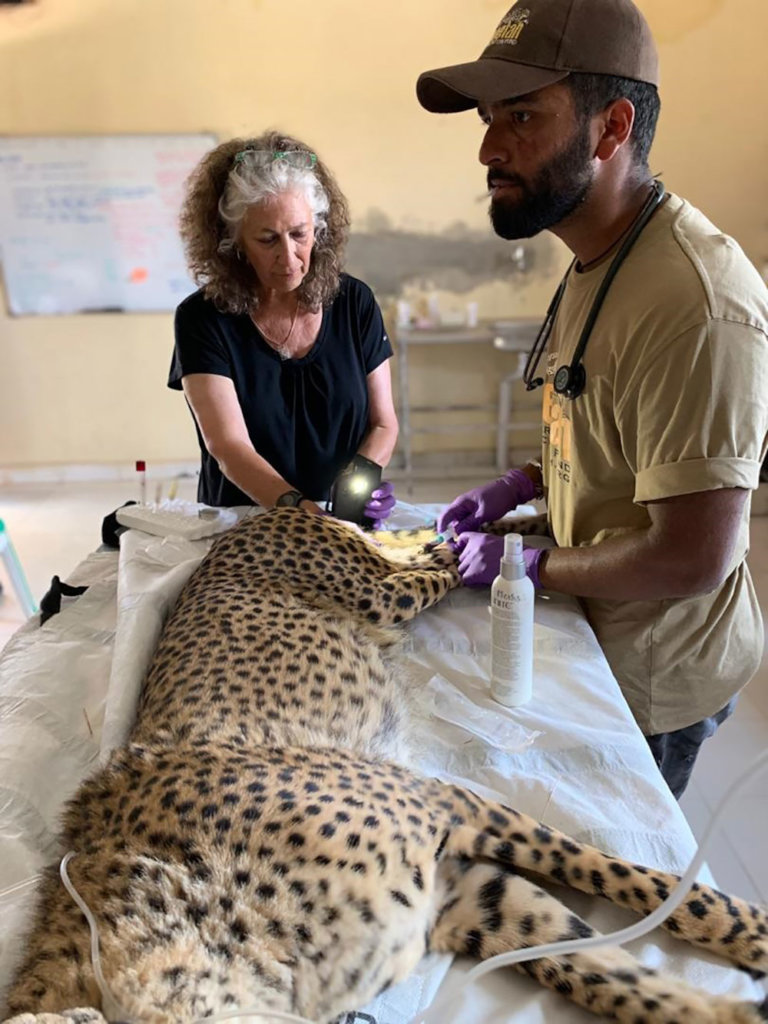
Dr. Mahesh Bhatt and Dr. Laurie Marker with Duma
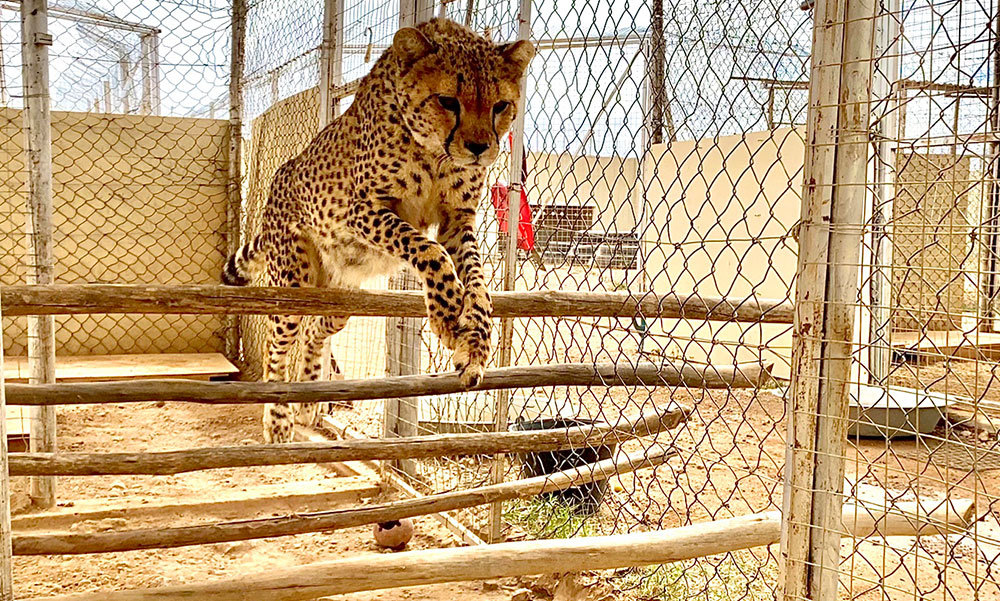
Duma getting therapy
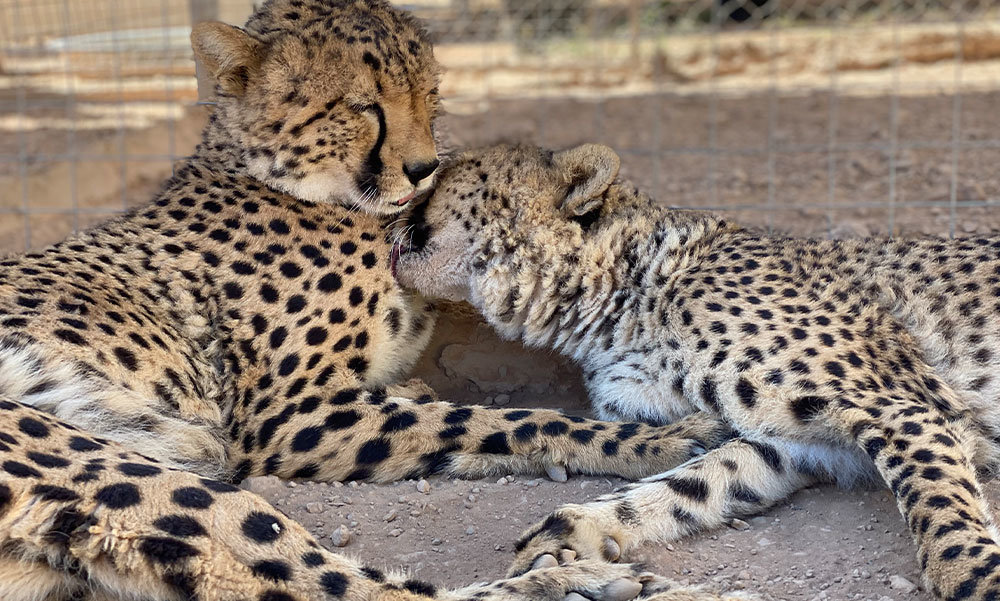
Duma with his mates
Links:
- YouTube
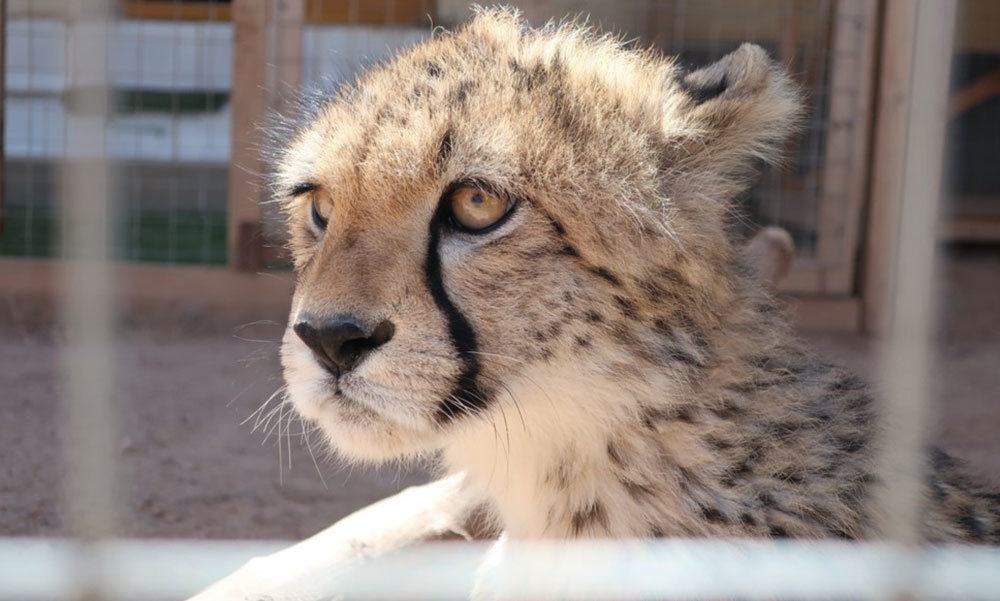
Cheetah cub at CCF Safe House in Hargeisa
Immediate action is needed to protect cheetahs in this region, which are at high risk of local extinction.
OTJIWARONGO, Namibia — April 22, 2021 — Cheetah Conservation Fund (CCF) today announces a global campaign to "Eliminate, Neutralize and Disrupt (END) Cheetah Trafficking", a worldwide effort to put an end to the poaching of cheetah cubs to supply the illegal pet trade. From 22nd April through 22nd June 2021, CCF and its network of affiliated organisations will conduct activities to generate awareness for the threat and raise funds for CCF's work. CCF will also engage its social media audiences in dialogue on the issue of cheetah trafficking.
An estimated 300 cubs are being taken from the landscape in the Horn of Africa each year due to a deadly combination of illegal wildlife trade and human-wildlife conflict, while the population of reproducing cheetahs (adult and adolescent) is estimated to be fewer than 500 individuals.
"Every cub taken puts us one step closer to losing cheetahs in the Horn. People must stop poaching now. Not only are communities draining their own natural resources, but their actions are decreasing local biodiversity, which makes for unhealthy landscapes and impacts human communities in profound ways", said Dr Laurie Marker, CCF's Founder and Executive Director. "In the age of COVID-19, the importance of having healthy landscapes has never been so clear".
Cheetahs are at a critical juncture in this part of Africa. Cubs are being stolen from their mothers in the wild to supply the international illegal exotic pet trade. They are also being taken domestically by nomadic farmers to prevent livestock predation, which is often mistakenly attributed to cheetahs. While the international trade in cheetahs is banned under CITES, animals continue to be smuggled from the Horn of Africa to the Arabian Peninsula via a well-established trade route between Somaliland and war-torn Yemen. The majority are sold via social media (Instagram and Facebook) and mobile phone apps, for the perceived status, likes and clicks. These actions are putting the population of cheetahs in the Horn of Africa at great risk for local extinction.
Why are Cheetahs Trafficked?
For thousands of years, the ancient world elite kept pet cheetahs as a status symbol. Today, there is still a high demand for cheetahs as pets, mainly emanating from Gulf states on the Arabian Peninsula. Cheetah cubs are snatched from rural areas in the Horn of Africa to meet this demand. Cheetah trafficking is mostly driven by poverty in the source countries. Some cheetahs are taken because of the illegal wildlife trade, while others are taken in a misguided attempt to prevent predation of livestock, then sold to traders as a means of disposal.
While buying captive-bred animals may still be legal, cheetahs are a species that historically do not breed well in captivity. To meet demand, want-to-be owners take pride in obtaining wild cheetahs, and they are not dissuaded by the illicit nature of the transaction, or they do not know the repercussion of this trade on the wild population. In some jurisdictions, it is still possible to legally acquire and possess the species, but the keeping of cheetahs as pets has been outlawed in most parts of the world.
Most prominently, the United Arab Emirates (UAE) instituted a national ban on exotic pets in 2016. CCF believes this law has been highly effective in reducing illegal trade and demand for wild cheetah cubs in the UAE, plus it has had a dampening effect in neighbouring countries.
CCF estimates that three out of four cubs taken from the wild (75%) will die before becoming a pet, having suffered from malnutrition, dehydration and lack of care in the hands of the traffickers. Of those that survive, the majority won't live beyond two years, due to improper care by unqualified owners.
Human-wildlife conflict, climate change and long periods of drought have placed additional pressure on rural farmers who live alongside cheetahs. Losing even one livestock animal to a wild predator can be financially devastating. In retaliation, they sometimes choose to sell cheetah cubs to recover their losses. A farmer in the Horn of Africa may receive up to $100 USD per cub, but a seller providing the cub to the end buyer may receive up to $10,000 USD per sale. CCF is committed to reducing both supply and demand.
CCF's campaign to end cheetah trafficking
CCF works with governments in the Horn of Africa and on the Arabian Peninsula to address the illegal wildlife trade in cheetahs. CCF assists the government of Somaliland by supporting wildlife seizure missions and providing immediate care for the cheetahs rescued. CCF is training veterinarians in Somaliland and Ethiopia to assist in these missions at the point of confiscation and to generate awareness for better livestock management practices. At the same time, CCF is building capacity in local wildlife authorities to enforce environmental laws through a project sponsored by UKAID's Illegal Wildlife Trade Challenge Fund, "Legal Intelligence/Cheetah Illicit Trade" (LICIT), and executed in partnership with Legal Atlas and the International Fund for Animal Welfare (IFAW).
From a base in Hargeisa, Somaliland's capital city, CCF also delivers round-the-clock care and rehabilitation for 56 cheetahs and one leopard rescued from the trade. CCF has established three 'Safe Houses' to temporarily provide shelter for these animals while developing plans for a CCF Rescue, Rehabilitation and Education Centre and cheetah sanctuary on land set aside by the government to become Somaliland's first national park. This new facility will provide naturalistic housing for the rescued cheetahs, and education and tourism opportunities for future generations of Somalilanders.
Caption: CCF's Founder and Executive Director, Dr Laurie Marker, leads an integrated international and local team of veterinary care providers in Hargeisa, Somaliland, that manage the growing number of cheetahs in CCF's care.
Cheetahs are Africa's most endangered big cat, listed as "Vulnerable" by the International Union for the Conservation of Nature (IUCN) Red List of Threatened Species. Fewer than 7,500 cheetahs remain in the wild worldwide, but this majestic cat is being pushed to the brink of local extinction in the Horn of Africa by cheetah trafficking.
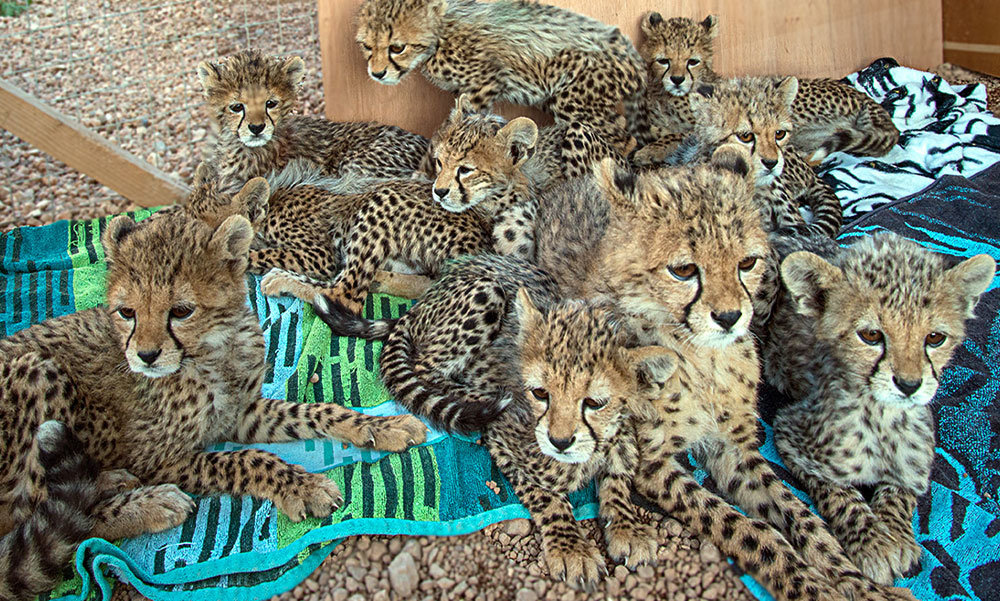
Ten of the eleven cubs seized in October 2019
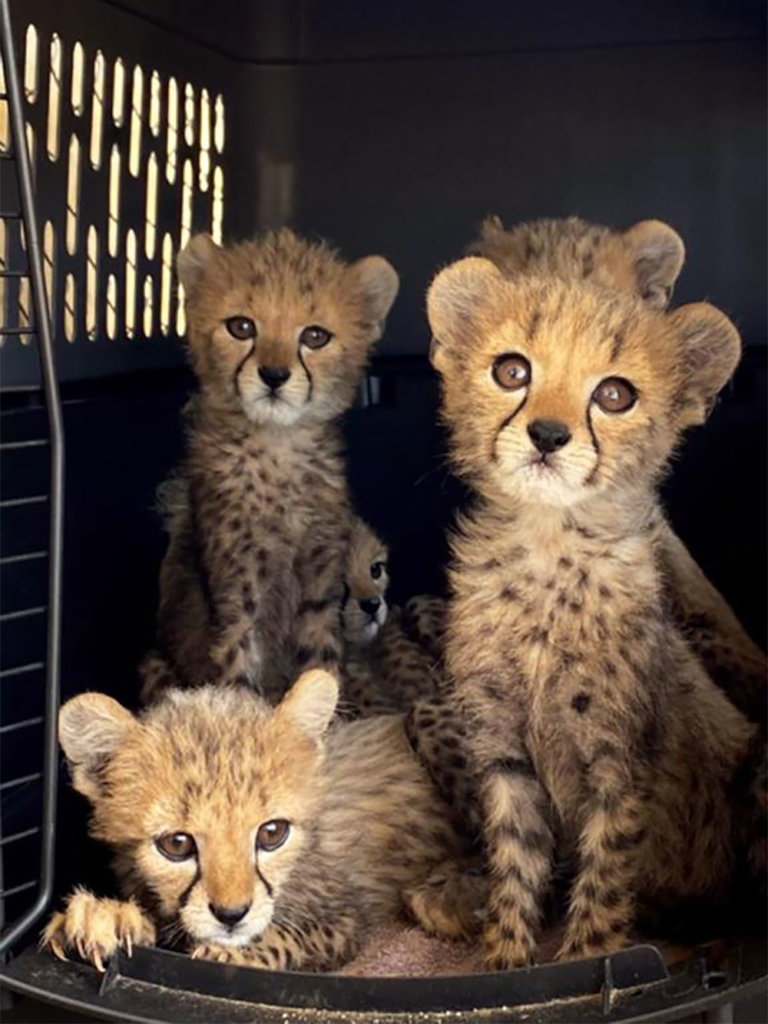
Five cubs arrive at the CCF Cheetah Safe House
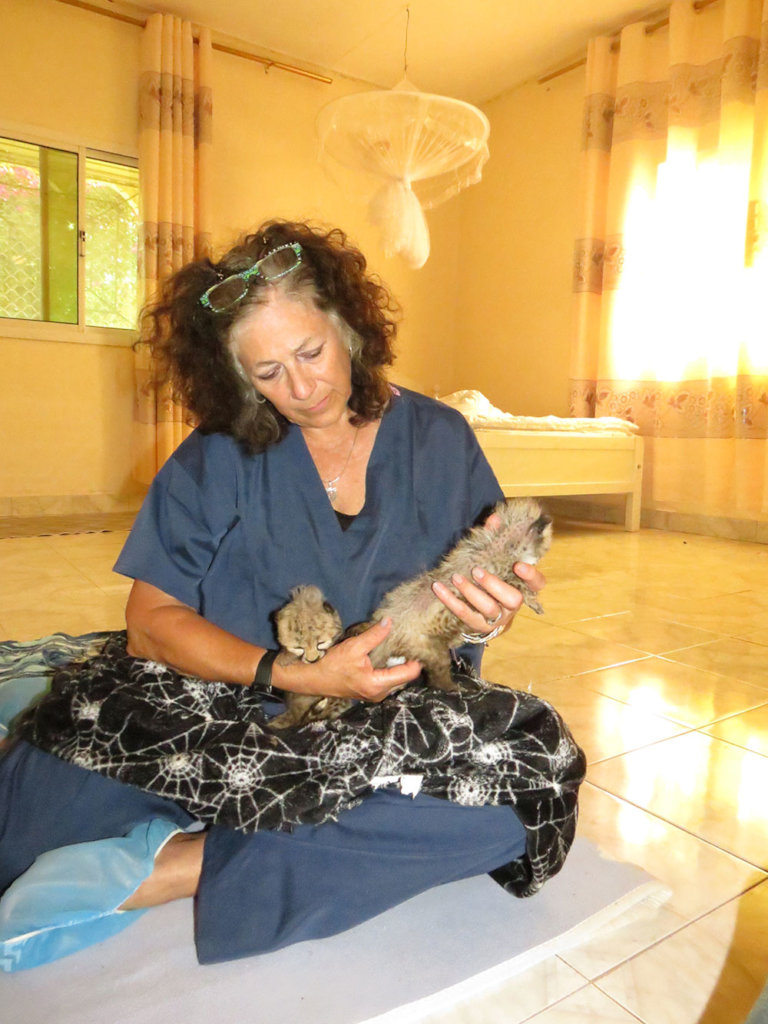
Dr. Laurie Marker giving care to cheetah cubs
Links:
- Youtube
Source: https://www.globalgiving.org/projects/feed-orphan-cheetahs-in-namibia/reports/
0 Response to "4 Easy High Paying Jobs Feeding Cheetahs"
Post a Comment